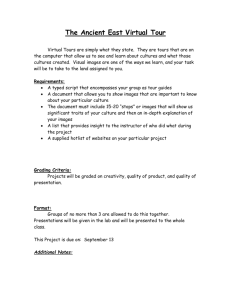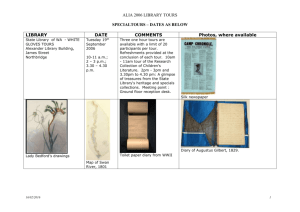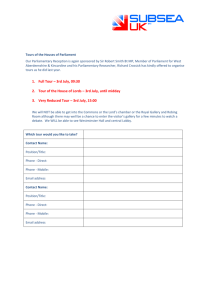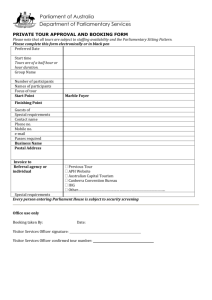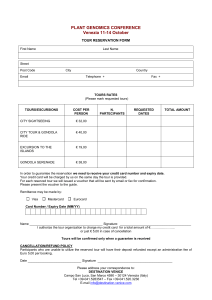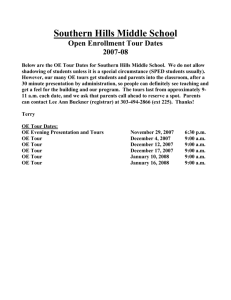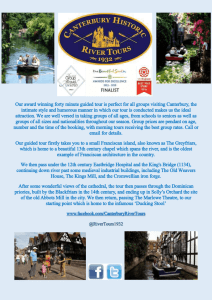COSTING OF A TOUR PACKAGE
advertisement
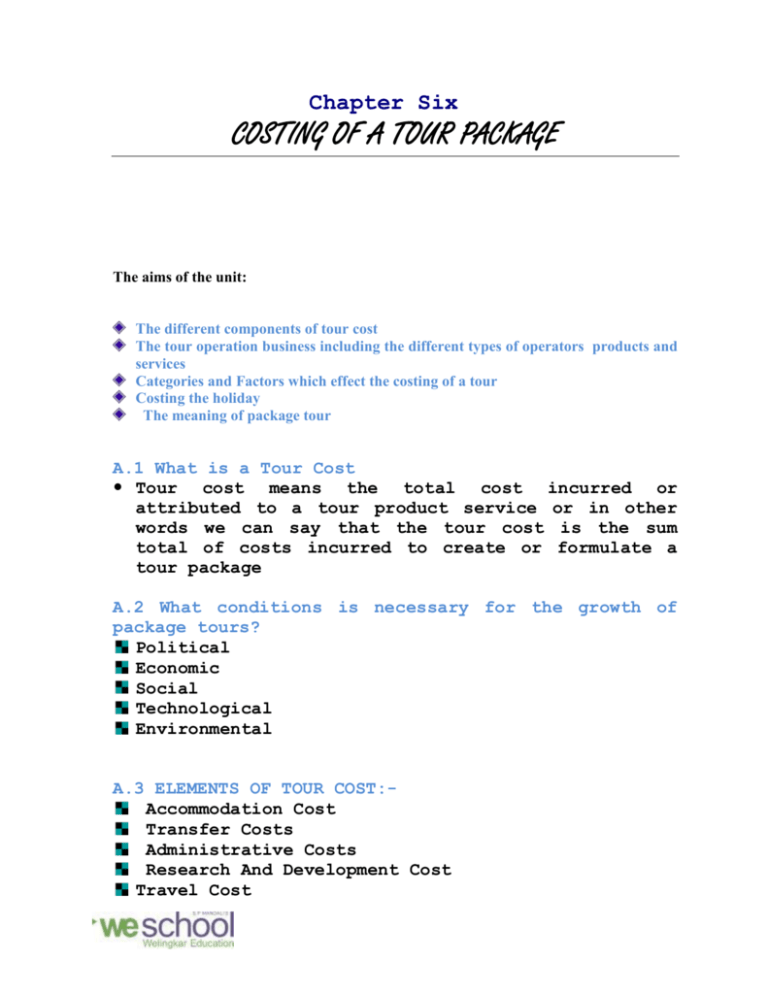
Chapter Six COSTING OF A TOUR PACKAGE The aims of the unit: The different components of tour cost The tour operation business including the different types of operators products and services Categories and Factors which effect the costing of a tour Costing the holiday The meaning of package tour A.1 What is a Tour Cost Tour cost means the total cost incurred or attributed to a tour product service or in other words we can say that the tour cost is the sum total of costs incurred to create or formulate a tour package A.2 What conditions is necessary for the growth of package tours? Political Economic Social Technological Environmental A.3 ELEMENTS OF TOUR COST:Accommodation Cost Transfer Costs Administrative Costs Research And Development Cost Travel Cost Marketing Costs Sightseeing And Activity Costs Miscellaneous Costs B.1 CATEGORIES OF TOUR COST Direct and indirect costs:Direct tour costs are those which are incurred and conveniently identified within a particular package tour Fixed and variable costs:Fixed costs are those which are incurred even when one is selling or not selling any tour package. B.2 FACTORS AFFECTING THE TOUR COST Seasonality Foreign Exchange fluctuations Competitors price strategy Increase in other costs. Impact of liberalization and globalization Promotional pricing/ special discounts Quality value ratio C.1 COSTING A TOUR PACKAGE:There is no fixed cost for the preparation of a confidential tariff and tour cost sheet. But in order to make the cost sheet more useful, it is usually prepared in columns form i.e., transfer, sightseeing, hotel, activities etc. ADVANTAGE OF A TOUR COST SHEET: It discloses the total tour costs and the cost per pax. It enables the tour company to keep a close watch and control over costs. It helps in fixing up the selling price more accurately. It helps the tour company to submit quotations. C.2 TOUR PRICING: A cost oriented pricing strategies 1 Cost-plus pricing · Marginal cost · Total cost · Mark up cost 2 Rate of return pricing B · · · · · · · · market oriented pricing strategies Discriminatory pricing Backward pricing Market penetration pricing skimming pricing Bundle pricing Yield management going rate pricing Loss-leader pricing C product line pricing strategies D industry/competition oriented pricing strategies · Tender pricing · differentiated Pricing Whatever pricing policy is adopted, a tour company has to take into consideration, the: · Market segmentation · Potential tourist’s perceptual assessment · Analysis of competitor’s pricing strategy · Assessment of the composition of the product · Analysis of external factors like political instability, events and other problems · Image of the destinations D.1 PACKAGE TOURS:1. Escorted tour leader/director accompanies tourists 2. Hosted - host meet tourists but does not accompany them 3. Packaged - provides transport and lodging but usually not host or leader 4. Independent - families/friends go together 5. Custom tours or Independent tours or Free independent travellers (FITs) 6. Group incentive tours (GITs): 7. Inclusive tours or packaging : 8. Business tours: D.2 ELEMENTS OF A PACKAGE TOUR: A package tour consists of the following components / elements: • Accommodation • Travel by airline / railway • Sightseeing • Guide / escort The above elements can be broadly classified into two parts: travel arrangements ground / land arrangements D.3 Package tours are of: Single country package tours :Organized for only one country-for example, china. Area tour package tours Organized for visiting more than one country, belonging to a common area. For example, tours to the south – East Asian countries such as Singapore, Thailand, and Malaysia; and tours to Europe and America. Single city tour package tour Organized for only a single city, for example, Aurangabad, Hyderabad, etc. Two city tour package tour Organized for two cities. For example, Delhi- Agra tour, jodhpur-Udaipur tour, etc Advantages to supplier:- It makes the product more attractive than if offered alone, thus increasing overall sales. It helps in improving sales during shoulder and low seasons. Makes the product easier to sell when two or more suppliers participate. Increases the possibility of cost economies of scale if certain volumes can be achieved. Provides better production recognition and reputation, particularly in new market. Package tours have a distinct advantage of saving time, as the tour operator plans and organize the travel details with the principle travel suppliers, for the tourist. It saves unnecessary correspondence. They work out to be cheaper than the other tours hence succeeds in reducing the real prices of travel abroad. It is comparatively cheaper and much easier to operate. People starting off at a short notice can also be assured of a smooth and comfortable tour. With the construction of winter holiday resorts, it succeeded in turning the travel agency into a year round business. Disadvantage of package tours: One of the greatest disadvantages of a package tour is that they are planned well in advance and there is no such package tour which has all the destination of the personal choice of a tourist, A tourist may not equally be interested in all the places that a package tour generally offers, and may have liked to see only limited places of that particular tour and some places contained in some other tour. In this package tour the tourist cannot change the itinerary as per his / her choice as it is already planned and prepaid. D.4 Tour Package Costing:A tour operator generally purchases three elements for creating an all inclusive tours: transport, accommodation and services (such as sightseeing, meals etc). main Technical terminology which is related to costing and pricing of packages: Mark Up: - It is the amount added to the cost price of goods to cover overheads and profit. Buying power:-Buying power is used to increase the profit by reducing the price from the principal suppliers on each sale for the package. Cash flow: - the total amount of money being transferred into and out of a business, especially as affecting liquidity. Net Rate: - Net rate is the price of the supplier meant for the retailers and on which you base your prices for your products and services. Gross Rate: - Gross rate is the rate which a supplier quotes to you for his or her products/services. Cash flow: - the total amount of money being transferred into and out of a business, especially as affecting liquidity. Net Rate: - Net rate is the price of the supplier meant for the retailers and on which you base your prices for your products and services. Gross Rate: - Gross rate is the rate which a supplier quotes to you for his or her products/services.

